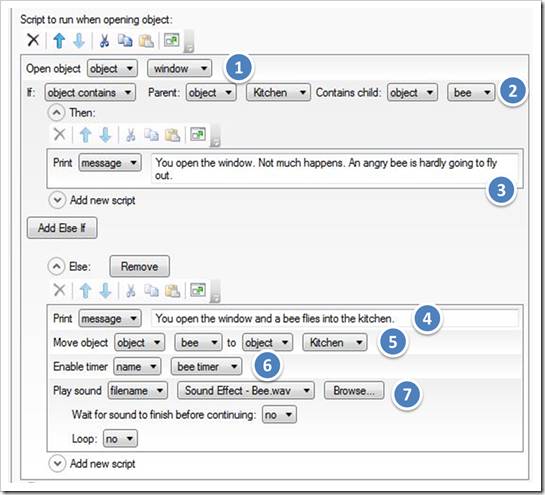 After two days exploring Quest 5 I am in so impressed by the platform. I have learnt an awful lot, created a really simple game, with very little coding ability. I am confident there is still much to learn under the ‘basics’ banner, however even the basics can be used to create quite sophisticated game play.
After two days exploring Quest 5 I am in so impressed by the platform. I have learnt an awful lot, created a really simple game, with very little coding ability. I am confident there is still much to learn under the ‘basics’ banner, however even the basics can be used to create quite sophisticated game play.
As I have found it, the main coding tool of Quest 5 is the humble script. A plugin and play tool that presents a wide range of default options, as well as referencing the objects and functions you have created. The critical observation here being that the actions programmed and the order they are presented are key to creating the desired outcome. I would liken the process to other ‘friendly’ programming tools such as Scratch and Kodu.
Scripting, moving objects during the game and using timers and turn scripts seems pretty straight forward. Combining these features also demonstrate the coding process in Quest 5 quiet nicely.
Here, a script questions whether or not the bee was previously, albeit accidently, let into the kitchen by opening a window. If the window is (re)opened1, Quest 5 asks if the kitchen “contains” a bee2. If true, the message reaffirms the position that “an angry bee is hardly going to fly out.”3 Otherwise (ELSE) the window is being opened for the first time a message is present4, and a bee is moved into the kitchen5. To add a sense of realism I have created a timer6 (not programmed here) and add my first sound effect7 that has a buzzing sound and “pesky bee” message repeating every 20s the player is situated in the kitchen, as long as the bee is still alive, that is.
Now, all I need to do is think of more reasons to move objects as the result of a players action and where timers would add to game play. Alternatively I need to play more Quests to magpie some ideas.
Creating a turn counter
Finally, for this post anyway, counters. Working with turn scripts to display a value, a progress measure and therefore feedback / assessment was pretty straightforward. The tutorial worked through running the script, storing the variable as an integer in the players attributes and displaying the values in a status area. Presumably Quest 5 can measure and display any defined variable, so my head is already spinning with ideas or KPIs that could be measured to offer in game feedback or end of game success or failure.
[qr_code_display]

